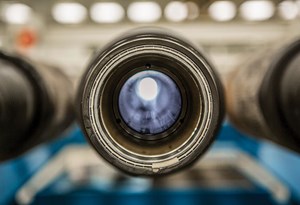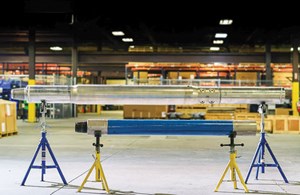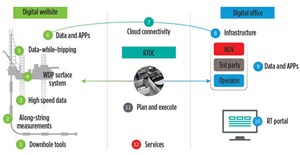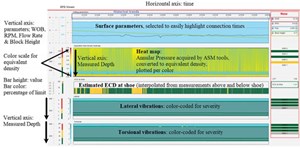Capturing real-time data during drilling and tripping operations improves efficiency and well placement
Companies are constantly challenged with the task of drilling wells safer, faster and with optimized well placement. Utilizing a combination of technologies, such as NOV’s IntelliServ wired drill pipe (WDP) network, in addition to an along-string measurement/enhanced measurement system (ASM/EMS) and a data while tripping (DWT) device, helps combat this challenge by providing previously unavailable real-time data during both drilling and tripping operations. This combined technology also eliminates the historical need to pump in or out of hole to collect real-time, high-speed data delivery while tripping.
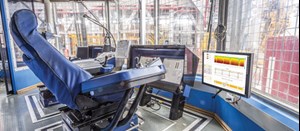
The WDP and additional M/D Totco tools have been deployed on multiple rigs, and they contributed to optimizing the well execution processes and aided in avoiding critical situations that could have resulted in wellbore abandonment. The measurements streamed by these technologies provided operators with a better understanding of downhole conditions that lead to optimized drilling practices and increased drilling speed.
The authors will describe WDP technology and how data are visualized at the surface. In addition, several case studies will be presented that document a step change in drilling performance for various field development projects and how operators managed wellbore stability and extended reservoir exposure in real time. They also will show the benefits from having real-time swab and surge while tripping on the elevator that allows for faster and safer operations.
WDP TECHNOLOGY
Wired drill pipe and along-string sensors. Communication between the surface and the BHA is typically established by using mud pulse telemetry (MPT), which relies on a minimum flowrate and a downhole-actuated valve systematically opening and closing. These movements generate pressure pulses, which are read and decoded at surface. The MPT signal quality is affected by flowrate, well depth, fluid parameters, and more. Bandwidth is typically limited to 5-40 bits per seconds (BPS).
The WDP network provides high-speed telemetry (HST) at up to 57,600 BPS, Fig. 1. The system is a linear network, consisting of an interface sub that establishes bi-directional communications with the measurement-/logging-while-drilling (M/LWD) tools. All drilling components, such as drill pipe, tubulars, subs, jars and accelerators, need to be wired to establish communications with downhole equipment. Repeater subs are added approximately every 300-400 m along the drill string, to amplify the signal all the way to surface. Finally, modified top drive components with cabling that serve as an interface between the surface acquisition system and the drill stem are installed. In the end, the surface network and computer systems collect and distribute the downhole data.
Based on the downhole network electronics of the repeater subs, optimization tools are also available on the WDP system. These can have a pipe-based design that is to then be included in drill pipe (DP) or heavyweight drill pipe (HWDP), Fig. 2. These also can have a collar-based design, in which case they will typically be placed above the BHA interface sub. The ASM tools include a high-frequency sensors package that allows for collection of annular and internal pressures, temperature, rotation, and three-axis vibration measurements along the drill string. Multiple ASM tools can be included in the drill string in addition to, or replacing, repeater subs. The collar-based enhanced measurement system (EMS) tool houses a similar instruments package as the ASM, with the addition of downhole torque, weight-on-bit (WOB), and bending moment sensors.
Data-while tripping device. The introduction of the DWT device has shown to be a success for both proving the value of deploying wired drill pipe (turning the lights on downhole), as well as staying connected to the downhole network while tripping (keeping the lights on downhole). Up until recently, the WDP system required the drill string to be connected to the top drive, to have communications to and from the downhole tools. Also, manual surface tests were needed while running in hole (RIH) to verify signal continuity.
The DWT device is a remotely operated retractable arm mounted on the top drive bails that enables connection to the WDP system, as the pipe is handled by the elevators. This significantly reduces the time spent testing the system, while increasing testing frequency, and removes the need for personnel in the red zone, thereby reducing the safety risk. The DWT device provides the option to collect information from WDP when tripping, without spending time connecting to the top drive. It allows for real-time monitoring of surge and swab effects and such insight can be highly beneficial in high-heave environment or narrow mud-weight window formations.
VISUALIZING THE DATA
The amount of data available for analysis is increased significantly with the use of WDP and ASM/EMS tools. It is critical that visualizations are adapted to enable quick and easy interpretation, so operators can decide on appropriate operational changes. Operations support teams, both at the rig site and in the office, can view the data, since they are aggregated into an electronic drilling recorder (EDR) and then distributed to the viewers in real time, Fig. 3. The data is are then available for users to configure plots by time and depth. Some operators have made specific WDP templates available company-wide, integrating all the additional signals provided by the downhole tools into the current user visualization.
Furthermore, data are displayed in a smart equivalent fluid density (EFD) viewer to help make sense out of the data acquired along the string. Fig. 4. It is important to combine time, depth, and the real-time measurements acquired from sensors placed at different inclinations, whether in cased or open hole. This viewer features a fluid density heat map: it is built by interpolating the equivalent mud weight (EMW) readings between the downhole sensors. This has, for example, been used successfully to monitor hole cleaning all along the wellbore and helped pinpoint pack-off locations.
To visualize the new set of data made available through the DWT, the EFD viewer has been a valuable tool to monitor annular pressure while tripping in and out of hole. By having real-time data from the ASM, operators have been able to assess impact of flow, block speed and acceleration on swab and surge. Figure 5 shows data streamed through the top drive while pulling out with flow on, and through DWT while pulling out on elevators. The flow-off interval is characterized by regular pressure drop (swab) as cold colors, quickly informing the operators the trip speed could potentially have on exposed formations.

Along-string measurements, combined with the DWT, have enabled operators to access downhole data previously never viewed in real time, revealing truths about the downhole pressure regime that both simplifies and complicates the planning of wells. Gaining access to this information has given operators the ability to make data-driven, qualitative decisions to effectively plan and drill ongoing and future wells.
Why use wired drill pipe? One of the single, most expensive operations on a field development is drilling. Therefore, it is critical for the operator to identify ways to reduce drilling time and cost, as well as prevent non-productive time (NPT). It has been determined that there are several ways that the use of WDP can help reduce costs. WDP helps improve operational efficiency, helps in avoiding drilling related issues, improves the resolution of challenges, and provides better well placement. Many operators continue to use WDP as a building block toward drilling automation, as it provides high-frequency, low-latency measurements from both BHA and ASM tools.
The latest-generation WDP technology and network system have been used on several different rigs in the North Sea, between 2016 and throughout 2020. More than 120 wells and approximately 220,000 m have been drilled, and the numbers continue to increase. The system has been deployed on several different types of wells, exploration and development, vertical and deviated/horizontal. In parallel, another 80+ wells have been drilled onshore in U.S. land, using the same technology.
The main difference between offshore and onshore has typically proved to be “drilling smarter” vs. “drilling faster,” respectively, in relation to factory drilling methodology applied in unconventional applications. Across these projects, we have seen wells with a total depth (TD) of a few hundred meters to up to approximately 7,500 m. In total, 516,693 m of total distance have been drilled with the WDP system in 210 wells since 2015, with a total uptime of 92.5% (actual data hours vs possible data hours).
CASE STUDIES
North Sea field development. An on-bottom ROP saw a major rise during an operator’s second phase of implementing HST and ASM technology. When using only MPT during the first phase of the drilling campaign, ROP was limited to get adequate logging data. WDP enabled increased downhole data acquisition in real time and near-instant surveys and downlinking. This allowed the operator to raise the ROP limit by an average 114% while still collecting a high-quality data set in real time. Additionally, ASM tools made it possible to evaluate the downhole conditions continuously. The quantity of cuttings was assessed to determine if the hole was being cleaned while drilling, or if ROP needed to be reduced.
Time to circulate hole clean is typically spent circulating hole clean after drilling to a section TD. The ASM tools provided annular pressure readings in real time and a visualization of the ECD distribution along the drill string. This was used to define the point at which the hole was in sufficiently good condition for tripping out and casing operations. A decision to shorten circulation time at TD was made, based on downhole data, rather than standard hole cleaning models.
Open hole time is measured as the time spent between drilling a new formation until casing/liner is landed. When a short open hole time is witnessed, that means that not only was the section drilled with a high ROP, but it also shows that the hole was in a good-enough condition to allow successful subsequent casing and liner runs. Throughout the campaign, open hole time was reduced consistently for all the sections, highlighting efficient well delivery.
Reservoir drilling in the North Sea. The WDP system was implemented at a field development on the Norwegian Continental Shelf (NCS) that plans to use a semisubmersible rig to drill and complete 24 wells, with an option for eight more. Advanced LWD tools generate large amounts of data that need to be transmitted to surface for monitoring and interpretation. This is used to decide on well placement and section depth, especially in reservoir sections. Even with modern data compression algorithms, the information generated by such tools typically exceeds the bandwidth of traditional MPT. The accepted compromise in the industry is to restrict ROP, in order to make informed decisions, based on the LWD data. WDP has proven significantly less limited by formation logging requirements than MPT, hence allowing to increase on-bottom ROP.
The operator’s rig drilled two reservoir sections that included advanced LWD tools. When drilling with MPT, the ROP limit was calculated to 25 m/hr. The two reservoir sections were planned and drilled with WDP, and the drilling speed limit was then adjusted to a maximum 60 m/hr. A conservative estimation on the total rig time saved by increased ROP totaled to 40 hours for these two wells.
Increasing ROP while geosteering on the NCS. The WDP system was used to drill several reservoir sections in the North Sea, along with geosteering services from a drilling services provider for a British multinational oil and gas company. The WDP provided nearly instantaneous bi-directional communication to and from the BHA. When using MPT during this drilling campaign, ROP was limited to 30 m/hr, to get adequate logging data. The real-time downhole data acquisition and near-instant surveys and downlinking from WDO enabled the operator to raise the ROP limit while still collecting a high-quality dataset in real time. Additionally, the ASM tools made it possible to ensure that the hole was cleaned while drilling.
Not only did WDP enable the operator to drill its wells safer, faster and with optimized well placement, it also increased ROP by 87.2%. During the drilling campaign, 9,854 m were drilled without ROP restrictions. Over six runs, a total of 6.48 days of time-savings in drilling was achieved. In the end, it was calculated that ROP with MPT was 23.83 m/hr and with WDP, the ROP was 44.62 m/hr.
Benefits of using the complete WDP system. The introduction of new, qualitative data has been one of the prime movers in drilling over the past decades. To receive and interpret valuable downhole information in real time enabled operators to make crucial decisions during drilling, improving drilling dynamics and well placement. Now, with wired pipe, these data are more abundant than ever before, and in combination with the ASM and DWT device, the entire string sends constant information to decision-makers during drilling and tripping.
Successful use of WDP depends on the following process: gathering downhole data, real-time data communication to surface, and visualization to enable fast interpretation and decide on operational changes. The cases presented demonstrate how this process has improved drilling efficiency and avoided drilling-related issues. Active use of the additional data is key to providing value from WDP. Furthermore, values from using the additional data can only be reached when decisions are taken during operations. Hence, WDP data need to be distributed and presented to decision-makers in real time. In addition, we have seen that accurate and reliable data transferred at high frequency provide operators with the ability to see the consequences of substantial rig heave and rapid tripping movements on the downhole pressure regime, risking influx or fractures in a fragile reservoir.
WDP has enabled a step toward continuous closed loop communication with downhole tools. As WDP infrastructure expands, further benefits are expected when performing well operations, such as using the telemetry for better well placement and including new tools with features that take advantage of high-speed telemetry. The authors believe that by using WDP over time, more value will be provided, due to emerging methods and tools that require improved telemetry.
- Coiled tubing drilling’s role in the energy transition (March 2024)
- Digital transformation/Late-life optimization: Harnessing data-driven strategies for late-life optimization (March 2024)
- The reserves replacement dilemma: Can intelligent digital technologies fill the supply gap? (March 2024)
- Digital tool kit enhances real-time decision-making to improve drilling efficiency and performance (February 2024)
- E&P outside the U.S. maintains a disciplined pace (February 2024)
- U.S. operators reduce activity as crude prices plunge (February 2024)

